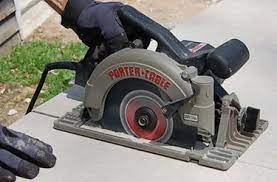You may be wondering, “Can you saw cut concrete after its cured?” The answer depends on several factors, including the concrete mix, weather conditions, and the hardness of the concrete. Cutting the concrete too soon can cause raveling, where the saw blade pulls the aggregate out of place. This results in an uneven edge along the cut. Cutting too late can result in uncontrolled cracking.
Cutting control joints
Cutting control joints after cured concrete is a necessary step in completing concrete projects. This step must be performed in the right manner to avoid raveling the concrete particles. Generally, control joints should be cut six to eighteen hours after the concrete has cured. However, if you are unable to wait that long, you should wait no longer than 24 hours. The exact drying time depends on the type of concrete and prevailing temperature. Therefore, timing is extremely important.
The spacing of control joints is usually 24 to 30 inches, depending on the concrete slab thickness. The control joints are then filled or sealed. The latter option involves filling the joint with a flexible material to allow it to withstand heavy traffic. However, if the concrete slab is not intended to withstand heavy traffic, you can leave it as is.
Cutting expansion joints
Cutting expansion joints after concrete has cured requires precise measurement and knowledge of the exact depth and width. In general, expansion joints should be 1/4 to 1/2 of the slab’s thickness. For example, a four-inch slab should have a joint that is 1 to 2 inches deep. If a joint is too thin, it could leak or crack the slab.
There are two methods of cutting expansion joints after concrete has cured: the sawcut method and the mechanical-insert method. The sawcut method is the more expensive option but produces a neater joint. The mechanical-insert method involves manually pushing a strip of plastic tape across the slab. This operation can be performed before or after bullfloating. It also allows the installer to control the joint depth and vertical embedment. The tape is installed at a depth just below the slab surface. When completed, the joint should have a fairly straight crack.
Cutting control joints with a wet saw
When cutting control joints, it is important to avoid sawing the concrete too soon after it has cured. This can result in ravelling and uncontrolled cracking. The ideal time to cut the joints depends on the weather. In hot weather, it is safe to start sawing four to eight hours after the concrete has cured. In cold weather, wait until at least 12 hours.
Control joints are cut into the concrete after it has cured to accommodate drying shrinkage and temperature changes. Depending on the type of concrete, they can be a quarter to one-half inch deep. The cuts should be accurate and should extend a minimum of 1/4 of the thickness of the slab. Failure to properly cut the joints within 6 to 12 hours could result in cracking.
Cutting control joints with a diamond blade
One of the most common problems with concrete is the need to cut control joints. Luckily, there’s a solution. The best way to cut these joints is with a saw, because it cuts the concrete after it’s hard enough to prevent chipping. However, you should still avoid cutting the joints when they’re still fresh and soft.
If you’re planning to cut control joints after concrete has cured, you should use a diamond blade. These blades are capable of creating some stunning effects, which is why they’re becoming more common on decorative concrete job sites.
Cutting control joints with a chainsaw
Cutting control joints after concrete has cured is an important construction process. These joints help prevent concrete from cracking. They can vary in depth and length, depending on the type of concrete and its usage. Cutting control joints is a tricky job and requires precision and timing. Cutting them too early can cause ravelling, which pulls the aggregates out of position and weakens the edges.
Concrete dust contains crystalline silica, which can cause lung scarring and Silicosis. To minimize exposure to concrete dust, use a wet cutting tool. This prevents concrete dust from being airborne. A waterproof, GFCI extension cord is also necessary. It helps prevent power surges, overloads, and electrical shocks.






